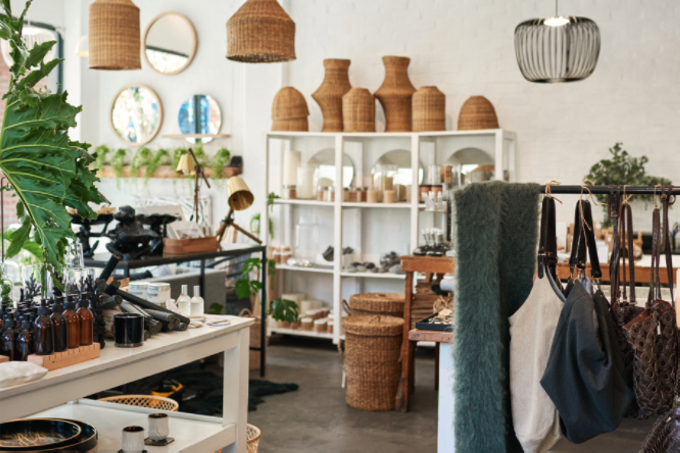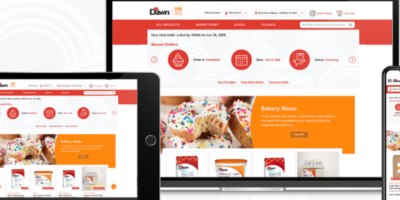
Web shoppers nonetheless have dwelling items and tasks on their plates, so category-wide shopping for and making the most of omnichannel conveniences stay robust.
House is definitely a class that noticed some swings throughout the pandemic and past. It’s probably that many consumers purchased dwelling items on-line for the primary time whereas seasoned customers bought broadly throughout this class. Our 2022 Digital Commerce 360 and Bizrate Insights dwelling items survey of 1,113 internet buyers speaks to the place customers stand immediately. After a number of years of many people dwelling and dealing at dwelling and the volatility of this class, I’ll incorporate a few of the year-over-year numbers to supply perspective.
Web shoppers admire the comfort of shopping for extra dwelling items on-line. 25% of internet buyers bought a minimum of half of their dwelling items on-line prior to now yr. 12 months over yr, internet buyers purchased a a lot decrease proportion of their dwelling items on-line, and it’s mirrored within the on-line buying penetration (2022 vs. 2021).
> 50%: 25% vs. 41%
< 50%: 75% vs. 59%
Dwelling décor and furnishings wants decline post-pandemic
Reflecting on these numbers leads me to consider general class wants have probably declined after sturdy buying throughout the pandemic. Whereas the pandemic pushed all customers to more and more buy dwelling items on-line, customers could now be retreating again to bodily shops. The tactile nature of dwelling items means customers nonetheless see a task for the shop post-pandemic.
People’ various dwelling actions probably drive class consumption. Curiosity in dwelling tasks/DIY and category-wide buying stays robust, and actions internet buyers cited embody normal dwelling upgrades (44%) and DIY tasks (42%). On a tangential word, the kicking off of tasks now that the pandemic has wound down (10%) and transferring (9%) additionally foster researching and buying within the class.
Dwelling-related actions additionally meant on-line analysis, with 27% of respondents searching for methods to boost their houses. 19% even perused social media to generate concepts.
12 months over yr, researching additionally was extra restricted as many consumers had already achieved their homework (27% vs. 44%). Additionally, internet buyers decreased budgets and tasks commensurate with wants. Given the pandemic frenzy round these actions, present conduct has tempered:
Dwelling upgrades: 44% vs. 37%
DIY: 42% vs. 47%
After all, saving cash is high of thoughts for a lot of. 37% reported making the most of promotions on merchandise of curiosity.
Cross-category buying is prevalent within the dwelling class. The next garnered on-line consumers’ consideration:
Out of doors house gadgets: 30%
New furnishings: 27%
Equipment substitute: 24%
Work-from-home (WFH) workplace wants: 14%
Consumers proceed to put money into their houses with extra restricted focus, so we’re seeing subsequent shifts in conduct. One the place an enormous year-over-year distinction (2022 vs. 2021) was seen was work-from-home workplace wants (14% vs. 21%). One can solely surmise that most individuals had arrange these areas throughout the preliminary yr of the pandemic with wants declining over time.
What options customers contemplate when looking for their houses on-line
Pricing opinions and knowledge that facilitate product comparability high the record of vital dwelling items shopping for options. Consumers admire robust product data together with merchandising and instruments that information buy conduct. That manifests itself in a want for pricing entry (68%) and scores/opinions (62%), which ought to be each built-in and well-populated. Retailers should give on-line dwelling items customers robust visible depictions of merchandise for optimum decision-making. Consumers deemed vital the skill to zoom in on a picture (47%) and shopper-generated images (25%). Instructional content material is essential to delivering an exemplary buying expertise, and most favored was the flexibility to match merchandise (55%).
Showcasing merchandise together with suggestions evokes customers. 36% discover these vital when looking for dwelling items. Extra conventional merchandising techniques may resonate amongst on-line consumers together with that includes new merchandise (32%), high sellers (24%) and trending merchandise (17%).
Supply data deserves outstanding placement given persevering with provide chain woes. Right here, 40% of on-line consumers discover correct supply home windows vital in class shopping for.
Instructional instruments have an vital position to play. 34% of survey respondents see how-to guides as vital, and video is available in at 23%. Digital consumers spend important time researching, and this content material — if compelling — can information shopping for conduct. Taking it one step additional, customers are more and more eager about instruments that elevate the house items expertise. That features augmented actuality at 17%, room design at 15%, and styling profilers at 10%.
As extra customers check these capabilities, one can count on to see incremental progress. It’s fascinating that when year-over-year findings, these instruments appear to have grown in significance.
Instructional Instruments (2022 vs. 2021)
Potential to match merchandise: 55% vs. 61%
How-to guides: 34% vs. 22%
Movies: 23% vs. 14%
Augmented actuality: 17% vs. 8%
Room design instruments: 15% vs. 7%
Styling profilers: 10% vs. 4%
Like most classes on-line, Amazon leads the record of web sites shopped for dwelling items. Mass retailers Walmart and Goal comply with.
Slowdown in dwelling tasks impacts on-line spending
Publish-pandemic, DIY tasks nonetheless prevail, although they could be restricted and smaller in scope. Although many tasks had been accomplished throughout the pandemic, 39% of our survey respondents are nonetheless in DIY mode. Moreover, with work at home now customary fare for many people, solely 10% recommend additional upgrades are probably. Total, solely 11% are utilizing extra professionals.
Our analysis means that each the quantity and scope of tasks post-pandemic are usually smaller and extra restricted. From a measurement perspective, 23% point out their tasks are smaller, versus 17% who’ve bigger plans in place. Scope-wise, the findings seem like comparable, with 23% smaller and 18% bigger.
Provide chain challenges stay, with 38% of internet buyers ready longer to get gadgets they order. Moreover, 19% needed to change retailers as a result of out-of-stocks, so we’re not out of the woods but.
Web shoppers embrace add-on providers
Many dwelling items customers want providers. These can vary from meeting to design, all in hopes of effectively managing their tasks. Virtually half of internet buyers are more likely to reap the benefits of these add-on providers alongside their dwelling items buying. Retailers have alternatives to safe incremental income. Strategically positioning such providers gives a invaluable add-on for these consumers.
On-line furnishings and décor experiences are multifaceted
Consumers can have a spread of experiences when shopping for dwelling items on-line, so a radical assessment of those shopper findings ought to assist direct retailers of their funding methods. Cell analysis and buying is prevalent, with 46% indicating it’s a part of their previous experiences. Thus, monitoring one’s cell consumer expertise (UX) is essential given this heightened utilization.
Content material drives buying, necessitating that dwelling items retailers make investments to each educate and encourage customers. It begins with the 37% who’ve watched video and consists of perusing Pinterest or different social media (24%). Those that watch TV/dwelling and backyard reveals (23%) and lastly those that learn blogs on this class (13%) additionally consider.
Whereas instruments and providers see decrease penetration, they serve to help customers trying to embrace what’s new within the class. Findings amongst these surveyed recommend that 12% have custom-made furnishings, 11% used augmented actuality instruments and 9% tried 3D room planners. 12 months-over-year utilization was on an upward trajectory as famous under (2022 vs. 2021):
Personalized furnishings: 12% vs. 8%
Augmented actuality: 11% vs. 6%
3D room planners: 9% vs. 4%
Although many indicated they’re eager about utilizing dwelling providers, not even 10% really had such experiences over the previous six months. It was important that each one these providers had greater expertise ranges.
Appointment for dwelling providers: 9% vs. 6%
Used Dwelling Advisor/Activity Rabbit providers: 7% vs. 4%
Booked meeting on-line: 6% vs. 2%
In-store appointment: 5% vs. 1%
Digital appointment: 4% vs. 1%
Product availability and retailer pickup are each an element when shopping for for the house
The shop is an integral a part of dwelling items buying, making it important that product locators, correct stock, BOPIS and curbside choices be in place. 43% of respondents examine for product availability at native shops, and it could now be a part of deciding whether or not or to not go to a retailer. For retailers, the excellent news is that 23% did, the truth is, go to a retailer as a part of their buying journey. From there, an analysis comes into play: pickup or supply? Publish-pandemic, many consumers proceed to make use of these store-based conveniences to finish their dwelling items purchases, with 32% making the most of BOPIS and 25% having fun with the curbside possibility.
The give attention to stock diminishes together with omnichannel exercise, although supply points stay. Omnichannel did see some year-over-year declines as maybe customers wished to reap the benefits of bodily shops. This class is tactile by nature, in any case.
Examine for product availability at native shops: 43% vs. 56%
BOPIS (purchase on-line, decide up in retailer): 32% vs. 40%
Curbside: 25% vs. 30%
Out-of-stocks: 41% vs. 46%
Inventory, late deliveries, cancellations and logistics are all issues for internet buyers given lingering provide chain challenges. Sadly, 41% encountered out-of-stocks when buying on-line. 25% skilled late deliveries, and 16% even had their orders canceled. More and more, extra internet buyers are looking for same-day supply choices and on this class, 18% embraced such a comfort.
Consumers proceed to check incremental providers. Right here, 11% used haul-away providers, whereas 5% had signed on for white glove providers.
When requested to consider their future spend within the dwelling items class, 4 in 10 internet buyers anticipate spending much less on dwelling items in 2022. From a top-line perspective, 42% count on their spending to be on par with final yr. Solely 17% count on to spend extra, and sadly 41% will spend much less, which will definitely have bottom-line implications.
Competitors for the house items shopper will probably be fierce for the rest of 2022. With tasks restricted and shopper spending comparatively flat, it will likely be as much as the retailers to encourage, inform and repair customers to seize and maintain their enterprise within the months forward.
Keep on high of the newest developments within the ecommerce business. Join a complimentary subscription to Digital Commerce 360 Retail Information.
Observe us on LinkedIn, Twitter and Fb. Be the primary to know when Digital Commerce 360 publishes information content material.
Favourite




















